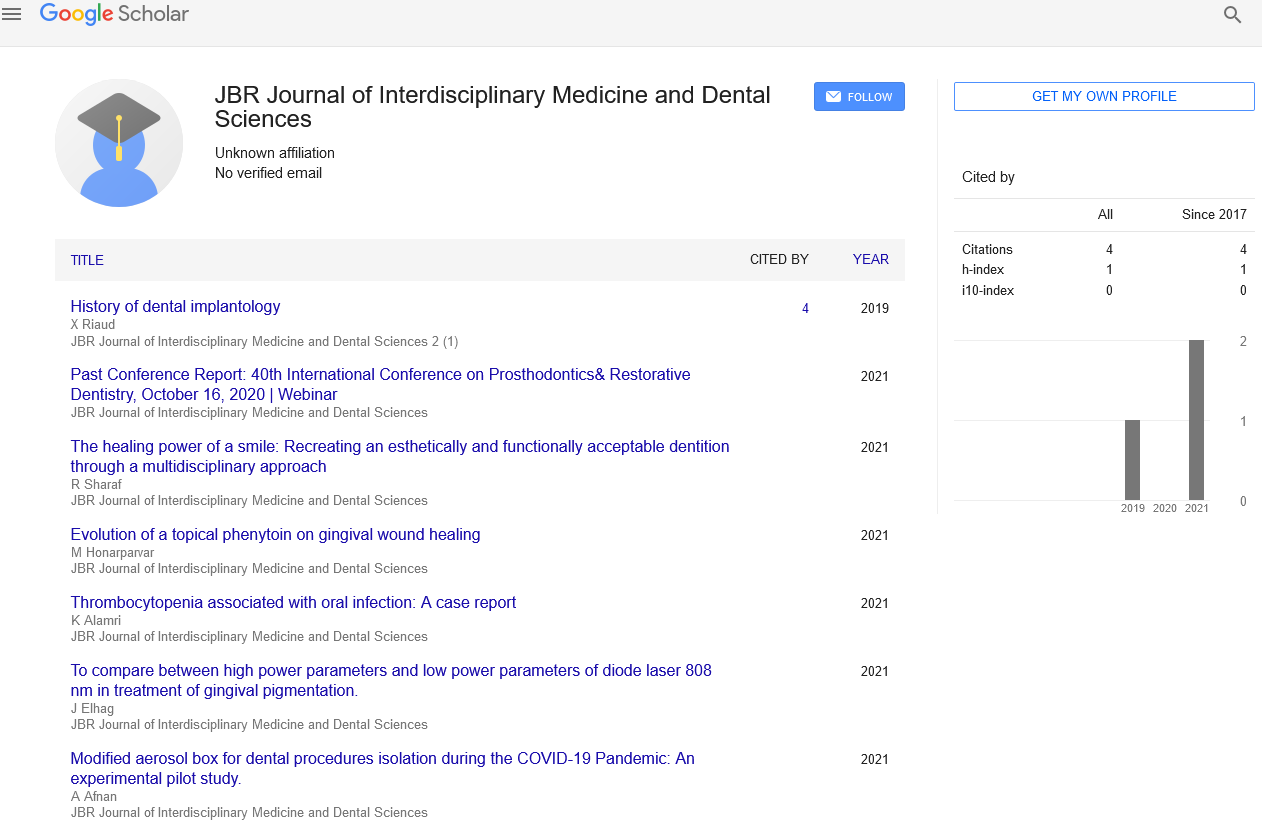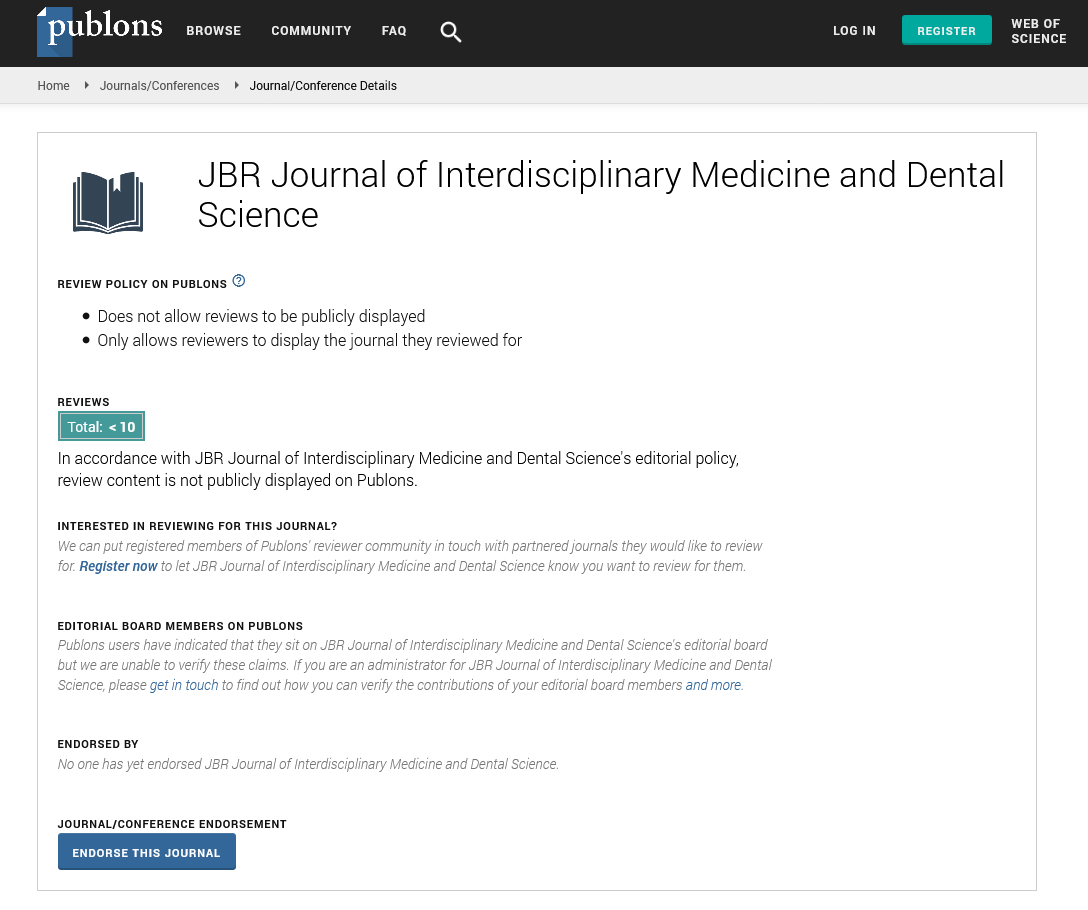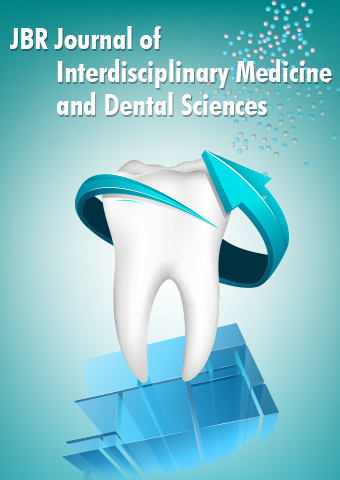Case Report - JBR Journal of Interdisciplinary Medicine and Dental Sciences (2023) Volume 6, Issue 4
Advancements in Dental Biomaterials: Paving the Way for Optimal Patient Care
Piyush Sharma*
Department of Dental Medicine, India
Department of Dental Medicine, India
E-mail: sharma_p69@gmail.com
Received: 1-July-2023, Manuscript No. jimds-23-108299; Editor assigned: 4-July-2023, PreQC No. jimds-23-108299 (PQ); Reviewed: 19-July-2023, QC No. jimds-23-108299; Revised: 24-July-2023, Manuscript No. jimds-23-108299 (R); Published: 31-July-2023, DOI: 10.37532/2376- 032X.2023.6(4).86-88 ISSN 2376-032X Case Report
Abstract
Dental biomaterials have undergone remarkable advancements, transforming the landscape of modern dentistry and elevating patient care to unprecedented levels. This article explores the key developments in dental biomaterials and their profound impact on dental treatments. From aesthetic and durable dental composites to natural-looking dental ceramics, these materials have revolutionized restorations and replacements. The advent of computer-aided design and computer-aided manufacturing (CAD/CAM) technology has further improved the precision and efficiency of dental ceramics. Moreover, dental implants have become the gold standard for tooth replacement, with surface modifications and digital technologies enhancing their success rates. In the domain of regenerative dentistry, biodegradable and bioactive materials have opened new avenues for supporting tissue regeneration and remineralization. This abstract highlights how the continuous evolution of dental biomaterials has enabled dentists to provide superior oral rehabilitation and regenerative solutions, ultimately benefiting patients with healthier, more functional, and aesthetically pleasing smiles. As research and technology persist, the future promises more innovative dental biomaterials, further revolutionizing the practice of dentistry.
Keywords
Regenerative dentistry • Guided implant surgery • Resorbable membranes • Tooth-colored aesthetics • Remineralization
Introduction
Dental biomaterials have long been at the forefront of dental advancements, playing a pivotal role in the restoration and preservation of oral health. These specialized materials encompass a diverse array of substances meticulously designed to interact with the oral environment while delivering optimal functional and esthetic outcomes [1]. Over the years, continuous research, innovation, and advancements in materials science and technology have led to significant improvements in dental biomaterials, revolutionizing the landscape of modern dentistry. The restoration and replacement of damaged or missing teeth are fundamental aspects of dental care, and the selection of appropriate biomaterials is paramount to ensure the success and longevity of treatments [2]. Dental composites, ceramics, and implants have emerged as stalwarts in restorative dentistry, offering exceptional versatility, durability, and aesthetics. Moreover, the integration of digital technologies, such as computer-aided design and computer-aided manufacturing (CAD/CAM), has elevated precision, efficiency, and patient outcomes in dental prosthetics [3]. Beyond the realm of restorations, dental biomaterials have also made significant strides in the field of regenerative dentistry. The development of biodegradable and bioactive materials has ushered in a new era of therapies that support natural tissue regeneration and promote remineralization, fostering a minimally invasive approach to treating oral tissue defects and early carious lesions [4]. In this article, we delve into the key advancements in dental biomaterials, shedding light on their respective contributions to modern dentistry. From their role in enabling natural-looking aesthetics to providing solutions for tissue regeneration, dental biomaterials stand as a testament to the synergy between scientific innovation and clinical excellence [5]. As we explore the dynamic world of dental biomaterials, it becomes evident that their evolution continues to shape the future of dental practice, promising ever-improving patient care and promoting healthier, more functional, and aesthetically pleasing smiles.
Discussion
Dental biomaterials play a crucial role in modern dentistry, contributing significantly to the longevity and success of dental treatments. These materials have evolved over the years, driven by extensive research and technological advancements. Dental biomaterials encompass a wide array of substances used to restore, replace, and enhance the oral structures affected by various dental conditions [6]. From dental composites to dental ceramics, these materials have revolutionized the field of dentistry, providing practitioners with innovative solutions to deliver superior patient care. In this article, we will explore the key advancements in dental biomaterials and their impact on dental treatments.
Dental composites: aesthetic and durable
Dental composites have gained immense popularity in recent years due to their excellent aesthetic properties and impressive durability. Composed of a resin matrix filled with inorganic particles, composites can be color-matched to natural teeth, making them ideal for restoring cavities in visible areas [7]. Advances in nanotechnology have led to the development of nanofilled and nanohybrid composites, which offer superior strength and wear resistance compared to earlier generations. Furthermore, improvements in bonding agents have strengthened the bond between composite materials and tooth structures, reducing the risk of debonding and enhancing the longevity of restorations.
Dental ceramics: achieving natural-looking restorations
Dental ceramics have been extensively used for fabricating crowns, veneers, inlays, and onlays. One of the significant advancements in this area is the advent of computer-aided design and computer-aided manufacturing (CAD/ CAM) technology [8]. CAD/CAM systems enable precise digital scanning of teeth, leading to accurate restoration design and efficient milling processes. This results in restorations with optimal fit and exceptional esthetics, closely mimicking the appearance of natural teeth. Additionally, improvements in the composition of dental ceramics have increased their fracture resistance, ensuring long-lasting and reliable restorations.
Dental implants: enhancing oral rehabilitation
Dental implants have revolutionized the way dentists approach tooth replacement. Titaniumbased implants have been the gold standard for decades due to their biocompatibility and osseointegration capabilities. Recent developments have focused on surface modifications, such as nanostructured coatings, to accelerate the osseointegration process and improve implant stability [9]. Additionally, zirconia implants have emerged as an alternative for patients with metal allergies, combining biocompatibility with tooth-colored aesthetics. The integration of digital technologies, including 3D printing and guided implant surgery, has also streamlined the implant placement process, ensuring predictable and successful outcomes.
Biodegradable and bioactive materials: pioneering regenerative dentistry
Advancements in dental biomaterials have extended beyond restorations and replacements to the realm of regenerative dentistry. Biodegradable materials, such as resorbable membranes and scaffolds, are used to support tissue regeneration in periodontal and bone defects. These materials provide a temporary framework for new tissue growth, gradually breaking down as the tissue heals, reducing the need for additional surgeries [10]. Additionally, bioactive materials like calcium phosphate-based cements and composites can stimulate mineral deposition and promote remineralization in tooth structures, offering a non-invasive approach to treat early carious lesions.
Conclusion
The evolution of dental biomaterials has been nothing short of remarkable, transforming the practice of dentistry and enhancing the quality of patient care. The relentless pursuit of scientific knowledge and technological innovations has resulted in dental composites, ceramics, and implants that offer unparalleled strength, durability, and aesthetics. CAD/CAM technology has revolutionized the fabrication of dental restorations, ensuring precise fits and superior outcomes. Moreover, the emergence of biodegradable and bioactive materials has opened new horizons in regenerative dentistry, providing effective solutions for tissue repair and remineralization. These materials offer promising alternatives to traditional therapies, promoting minimally invasive approaches and natural tissue healing. As the research and development of dental biomaterials persist, we can anticipate even more groundbreaking discoveries and advancements in the years to come. From improved bonding agents to novel nanotechnology applications, the future promises to elevate dental biomaterials to unprecedented levels of performance and patient satisfaction. Dentists and dental professionals must stay abreast of these advancements, integrating the latest materials and technologies into their practices to deliver optimal patient outcomes. By harnessing the potential of these cutting-edge biomaterials, practitioners can continue to provide patients with healthier, more resilient, and aesthetically pleasing smiles. In conclusion, dental biomaterials have proven to be the bedrock of modern dentistry, enabling dentists to restore, replace, and regenerate oral structures with precision and finesse. Through a synergistic combination of science, artistry, and technology, these materials have cemented their position as indispensable tools in the pursuit of comprehensive dental care. As we look to the future, the journey of dental biomaterials is one of endless possibilities, promising a world where oral health thrives and smiles shine brighter than ever before.
References
- Sarikaya I, Güler AU. Effects of different surface treatments on the color stability of various dental porcelains. Journal of Dental Sciences. 6, 65-71 (2011).
- Motro PF, Karagoz PK, Kazazoglu E. Effects of different surface treatments on stainability of ceramics. The Journal of prosthetic dentistry.108, 231-237 (2012).
- Sarıkaya I, Yerliyurt K, Hayran Y. Effect of surface finishing on the colour stability and translucency of dental ceramics. BMC Oral Healt.18, 1-8 (2018).
- Meral K, Bilge TB. Effects of accelerated artificial aging on the translucency and color stability of monolithic ceramics with different surface treatments. The Journal of prosthetic dentistr.121, 712-e1 (2019).
- Atay A, Karayazgan B, OzkanY et al. Effect of colored beverages on the color stability of feldspathic porcelain subjected to various surface treatments. Quintessence International.40 (2009).
- Kanat‐Ertürk, Burcu. Color stability of CAD/CAM ceramics prepared with different surface finishing procedures. Journal of Prosthodontics.29, 166-172 (2020).
- Derafshi R, Khorshidi H, Kalantari M et al. The effect of chlorhexidine mouth rinse on the colour stability of porcelain with three different surface treatments: An in vitro study. Journal of Dental Biomaterials.1, 3-8 (2014).
- Köroğlu A, Sahin O, Dede DO et al. Effect of different surface treatment methods on the surface roughness and color stability of interim prosthodontic materials. The Journal of prosthetic dentistr.115, 447-455 (2016).
- Atay A, Oruç S, Ozen J et al. Effect of accelerated aging on the color stability of feldspathic ceramic treated with various surface treatments. Quintessence International.39 (2008).
- Alp, Gulce. Effect of surface treatments and coffee thermocycling on the color and translucency of CAD-CAM monolithic glass-ceramic. The Journal of prosthetic dentistry120, 263-268 (2018).
Indexed at, Google Scholar, Crossref
Indexed at, Google Scholar, Crossref
Indexed at, Google Scholar, Crossref
Indexed at, Google Scholar, Crossref
Indexed at, Google Scholar, Crossref
Indexed at, Google Scholar, Crossref
Indexed at, Google Scholar, Crossref


